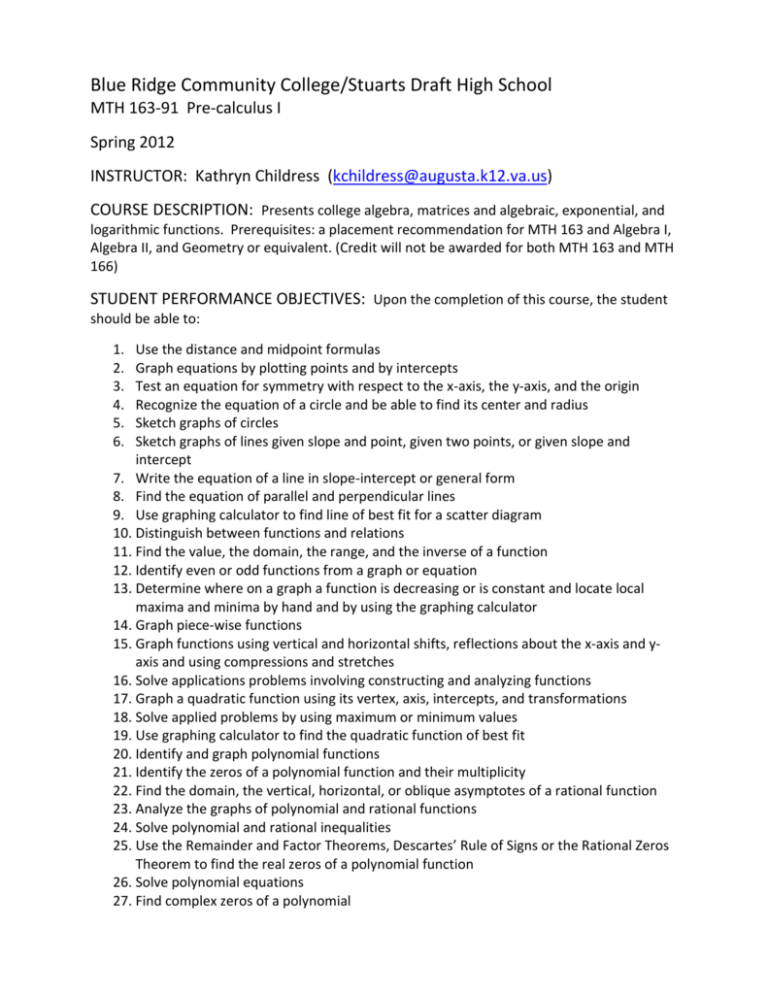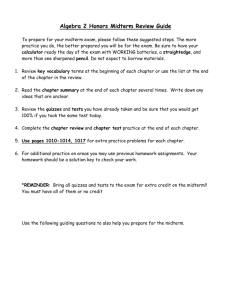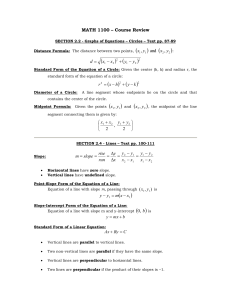
Blue Ridge Community College/Stuarts Draft High School
MTH 163-91 Pre-calculus I
Spring 2012
INSTRUCTOR: Kathryn Childress (kchildress@augusta.k12.va.us)
COURSE DESCRIPTION: Presents college algebra, matrices and algebraic, exponential, and
logarithmic functions. Prerequisites: a placement recommendation for MTH 163 and Algebra I,
Algebra II, and Geometry or equivalent. (Credit will not be awarded for both MTH 163 and MTH
166)
STUDENT PERFORMANCE OBJECTIVES: Upon the completion of this course, the student
should be able to:
1.
2.
3.
4.
5.
6.
Use the distance and midpoint formulas
Graph equations by plotting points and by intercepts
Test an equation for symmetry with respect to the x-axis, the y-axis, and the origin
Recognize the equation of a circle and be able to find its center and radius
Sketch graphs of circles
Sketch graphs of lines given slope and point, given two points, or given slope and
intercept
7. Write the equation of a line in slope-intercept or general form
8. Find the equation of parallel and perpendicular lines
9. Use graphing calculator to find line of best fit for a scatter diagram
10. Distinguish between functions and relations
11. Find the value, the domain, the range, and the inverse of a function
12. Identify even or odd functions from a graph or equation
13. Determine where on a graph a function is decreasing or is constant and locate local
maxima and minima by hand and by using the graphing calculator
14. Graph piece-wise functions
15. Graph functions using vertical and horizontal shifts, reflections about the x-axis and yaxis and using compressions and stretches
16. Solve applications problems involving constructing and analyzing functions
17. Graph a quadratic function using its vertex, axis, intercepts, and transformations
18. Solve applied problems by using maximum or minimum values
19. Use graphing calculator to find the quadratic function of best fit
20. Identify and graph polynomial functions
21. Identify the zeros of a polynomial function and their multiplicity
22. Find the domain, the vertical, horizontal, or oblique asymptotes of a rational function
23. Analyze the graphs of polynomial and rational functions
24. Solve polynomial and rational inequalities
25. Use the Remainder and Factor Theorems, Descartes’ Rule of Signs or the Rational Zeros
Theorem to find the real zeros of a polynomial function
26. Solve polynomial equations
27. Find complex zeros of a polynomial
28. Form a composite function and find its domain
29. Determine and graph the inverse of a function
30. Evaluate and graph exponential functions
31. Define the number e
32. Solve exponential and logarithmic equations
33. Solve application problems dealing with exponential functions
34. Solve systems of equations by substitution and elimination
35. Solve system of equation with three variables
36. Identify inconsistent systems of equations containing two or three variables
37. Use Cramer’s Rule to solve a system of equations containing two or three variables
38. Perform matrix operations
39. Solve a system of inequalities by substitution or elimination
40. Graph a system of inequalities
41. Solve a linear progression problem
ATTENDANCE POLICY: The Stuarts Draft High School Student Handbook explains their
attendance policy, which this class will follow. The student is expected to attend all classes. It is
the student’s responsibility to get work missed from an absence. All work is to be made up
within 3 days. Make up work is graded as zero after 3 unexcused absences. In addition, you
need to be aware that BRCC expects you to attend every class. School related absences (i.e.
sports, choir, etc.) are not recognized by BRCC. Keep absences to a minimum. Notify the
instructor and get any work needed before the absence. In a college course, make-up work and
tests are given and/or accepted at the sole discretion of the instructor. In case of snow days,
work is to continue. Online assignments will be given to keep students up to date.
GRADING POLICY:
o 80% of the grade is from 7 tests each worth 100 points, various quizzes each worth 50
points, and several projects worth varying amounts of points
o 10% of the grade is from homework that is done on line or checked in class
o 10% of the grade is from class participation where 100 points are assigned and points
are deducted for rule infractions and absences.
o The grading scale will be based on percentages as follows:
90% - 100%
80% - 89%
70% - 79%
60% - 69%
Below 60%
A
B
C
D
F
There will be an exam that will count as 2 test grades.
TEXT:
Precalculus, 9th Edition, Sullivan; Pearson/Prentice-Hall, 2012
My Math Lab – Internet software with problems that coordinate to the text
INSTRUCTIONAL MATERIALS: Graphing Calculator will be used extensively in the class.
These are available in the classroom for in room use, but the student would benefit from having
their own calculator. The student also needs a 3-ring binder or spiral notebook, whichever
he/she is best at organizing. The student will also need internet access to do the online
homework assigned.
CLASS SCHEDULE AND SEQUENCE OF INSTRUCTION: The following is a tentative
schedule, and is subject to change at any time.
Week 1: January 18 - 20
1.1 Rectangular Coordinates
1.2 Graphs of Equations in two variables
1.3 Lines
1.4 Circles
Week 2: January 23 - 27
Quiz on Chapter 1
2.1 Functions
2.2 The Graph of a Function
2.3 Properties of Functions
2.4 Library of Functions: Piecewise-defined Functions
2.5 Graphing Techniques: Transformations
2.6 Mathematical Models
Week 3: January 30 – February 3
TEST on Chapters 1 and 2 – Graphs and Functions
3.1 Linear Functions and their properties
3.2 Building Linear functions from data
3.3 Quadratic functions and their properties
3.4 Quadratic Models: Building quadratic functions from data
Week 4: February 6 – 10
3.5 Inequalities Involving Quadratic functions
Test on Chapter 3
4.1 Polynomial functions and models
4.2 and 4.3 Properties of rational functions
Week 5: February 13 – 17
4.4 Polynomials and rational inequalities
4.5 Real zeros of a polynomial function
4.6 Complex zeros: Fundamental Theorem of Algebra
Test on Chapter 4
Week 6: February 21 – 24
5.1 Composite functions
5.2 Inverse functions
Quiz – functions
5.3 Exponential functions
5.4 Logarithmic functions
Week 7: February 27 – March 2
5.5 Properties of Logarithms
5.6 Logarithmic and exponential equations
Quiz – Logs
5.7 Compound Interest
5.8 Exponential growth and decay: models
TEST – Chapter 5
Week 8: March 6 - 9
11.1 Systems of linear equations: substitution and elimination
11.2 Systems of linear equations: matrices
11.3 Systems of linear equations: determinants
Quiz – System of equations
11.4 Matrix algebra
Week 9: March 12 - 16
11.6 Systems of non-linear equations
11.7 Systems of inequalities
11.8 Linear Programming
TEST – Chapter 11
EXAM: March 23
HONOR CODE
The functioning of an academic community depends on the integrity of all of its members. Blue Ridge Community College values
truthfulness, respect for the property of others, and honesty in academic work. Violations of these values may result in permanent
dismissal from the College. The Statement on Student Rights and Responsibilities, located in the Catalog and Student Handbook,
and the Statement on Academic Honesty below, provide specific guidelines which encompass this code.
Academic Honesty
When College officials award credit, degrees, diplomas, and certificates, they must assume the absolute integrity of the work done
by students; therefore, it is important that each student maintains the highest standard of honor in his or her scholastic work.
Academic dishonesty cannot be condoned. When such misconduct is established as having occurred, students are subject to
possible disciplinary actions ranging from admonition to dismissal, along with any grade penalty the instructor may impose in
accord with their syllabus and college policies. Procedural safeguards of limited due process and appeal are available to students in
disciplinary matters. Grade disputes about a grade assigned as a result of academic dishonesty can only be resolved through the
grade appeal procedure. No withdrawal policy outlined in the College Catalog and Student Handbook can supersede a grade penalty
assigned as a consequence of an academic honesty violation.
Academic dishonesty includes, but is not limited to, one of the following acts:
1.
Cheating on an examination or quiz, including the giving, receiving or soliciting of information, the unauthorized use of
notes or other materials during the examination or quiz.
2.
Buying, selling, stealing or soliciting any material purported to be the unreleased contents of a forthcoming examination,
or the use of such material.
3.
Substituting for another person during an examination and/or quiz, including online exams or quizzes, or allowing such
substitution for one’s self.
4.
Plagiarism. This is the act of using content and/or ideas from the work of another individual, either word for word or in
substance, and representing them as one’s own work. This includes any submission of written work other than one’s own.
There are three types of plagiarism as listed in Donald A. Sears’ book Harbrace Guide to the Library and Research Paper,
3rd Edition (New York: Harcourt, 1972, p. 45). They are:
a.
Word-for-word plagiarism: The submission of the work of another source without proper acknowledgment of
that source by footnote, bibliography or reference in the paper.
b.
Patchwork plagiarism: Submitting a work that is stitched together from a variety of sources that does not
indicate direct quotes or acknowledgment of those sources.
c.
Unacknowledged paraphrase: Restatement or rewording of another author’s original thought or idea must be
acknowledged. Restatement by means of paraphrase does not remove the necessity of giving credit to original
sources. Refer to the Library website for more information on plagiarism. (http://www.brcc.edu/library/)
5.
Collaboration with another person in the preparation or editing of assignments submitted for credit without advance
approval from the instructor.
6.
Knowingly furnishing false information to the College including, but not limited to, forgery, alteration or use of College
documents, or instruments of identification with intent to defraud.










